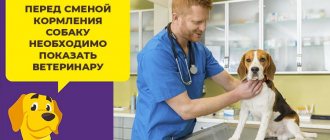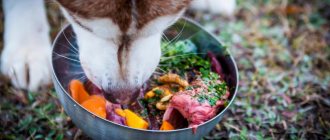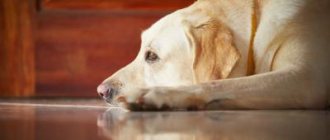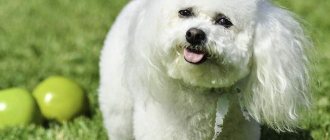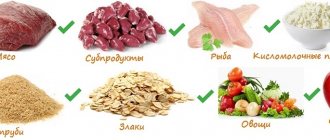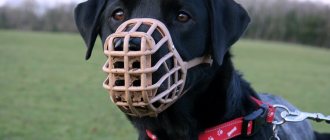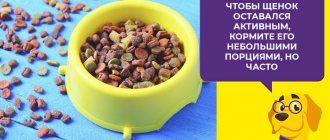Why is obesity dangerous in dogs?
Here are just some of the dangers:
- First of all, obesity is dangerous because it has a negative impact on all internal organs and leads to disruption of their normal functioning. The list of complications caused by obesity in dogs is extremely long: metabolic disorders, decreased immunity, gastrointestinal diseases, heart disease, liver and kidney problems, skin diseases, blindness. The list could take a very long time.
- In addition, excess weight puts severe stress on the spine, limbs and joints. Over time, they simply cannot stand it and deforming arthrosis develops. The dog simply can no longer move independently.
Weight norm
It is worth noting that after you have started losing excess weight in your dog, you need to know what the normal weight of a Labrador is so as not to overdo it with fat burning. For a male, the norm is considered to be from 35 to 40 kg, for a female - 25-30 kg.
In addition to nutrition, you should reconsider walking your dog. After all, you can often observe how dog owners talk peacefully, while their pets lie at their feet and don’t even try to play or run. You should know that a dog, like a child, requires attention, and during a walk it is much more interesting for it to play and run with you than with other dogs. Don’t be lazy and buy your pet a ball that you will throw to him, or a flying saucer for him to jump after.
Play actively with your Labrador, feed him correctly, and you will see how your dog will turn from a lazy and phlegmatic dog into a beautiful and healthy dog.
Causes of obesity in animals
There can be several reasons for obesity:
- Obesity can be caused by serious diseases: hormonal imbalance, diseases of the thyroid gland, and gastrointestinal tract.
- Constant stress can also affect weight gain. If obesity is a consequence of any disease, then diet alone will not help. Competent and comprehensive treatment and proper diet are necessary.
Before putting your dog on a diet and radically changing its usual diet, it is necessary to find out what caused the pet to begin to gain weight. To do this, you need to contact a veterinary clinic. The need and correctness of prescribing a particular diet should be determined by the doctor after a complete examination of the animal and receipt of test results.
- Another cause of obesity is parasites.
- As a rule, diseases are very rare causes of obesity in dogs. In most cases, the main causes of this disease are: common overeating, age and insufficient physical activity.
Obesity in a dog - the main reasons:
- binge eating,
- disturbances in the functioning of the dog’s endocrine system,
- the presence of parasites,
- lack of physical activity and sedentary lifestyle,
- incorrectly selected diet,
- genetic predisposition to obesity in some breeds.
There are no complex or expensive tips in this article; they are accessible to absolutely anyone, even those who are very far from everyday sports and fitness centers. The main thing is not to lose weight, but to rebuild the dog’s lifestyle and review its diet!
Types of diets
There are several types of diets for tailed pets. Let's look at them.
Hypoallergenic diet
The purpose of such a diet is to identify and then exclude from the dog’s diet foods that cause allergies in the pet. Such a diet begins with real experiments: the dog ate a pumpkin, began to itch - we don’t give him any more pumpkin. And so by the selection method. As a result, throughout his canine life the four-legged dog will eat only those foods to which he is not allergic.
Diet for obesity or castration in dogs
If the four-legged animal is not sick, but has grown fat from the “kindness of soul” of its owner, this illness should be urgently taken under control. As a rule, a diet for obesity or castration in dogs is a simple change and analysis of the diet, a banal reduction in portions by 10-15% and a gradual increase in physical activity.
In most cases, this works great, since the problem of obesity associated with overfeeding is a direct consequence of a slow metabolism (due to the fact that the body simply cannot cope with such a food load quickly) and an excess of calories entering the animal's body.
Diet for kidney disease in dogs
In general, in case of kidney disease, the basic principle of human nutrition is limited consumption of protein and fat. Guided by this principle, for many years veterinarians also prescribed a low-protein diet for kidney disease in dogs. However, as a result of numerous studies, in recent years this myth has been finally dispelled.
To date, there is no definitive evidence that feeding dogs with kidney disease a protein-rich diet actually harms the dog's health.
A dog is by nature a predatory animal. And “limiting protein in a dog’s diet can do more harm to the animal than good due to the risk of protein starvation” (G. Reinhart from the proceedings of the Dietetics Symposium).
Here are some links to a number of articles and studies on the role of protein in the diet of dogs with kidney failure. If you are the owner of a pet suffering from kidney disease, I advise you to read these publications:
- "Dogs with kidney disease" Dr. Lucy Pinkston, DVM.
- “Is a high protein diet bad for dog kidneys?” from the Veterinary Services Department, Drs. Foster & Smith, Inc.
- “Myths About Protein Restriction for Dogs with Reduced Kidney Function” by Kenneth Bovey, DVM, MS.
- “Enriched Nutrition for Aging Dogs” by Susan Thorpe-Vargas, PhD, and John S. Cargill, BS, MS.
- "Dispelling Myths About Squirrels" From Today's Breeder.
If your tail suffers from kidney disease, there is no doubt that a certain diet is definitely needed. But after a correct diagnosis, such a diet can only be developed by a competent veterinary specialist with modern knowledge and research, and not acting “the old fashioned way.” After all, science does not stand still, and in connection with new research opportunities, new competent approaches to what previously seemed to be unshakable postulates appear.
How to put a dog on a diet
So, how do you diet your dog? First of all, you should start with yourself. The owner must strictly follow all the rules, without following the dog’s lead due to forgetfulness or pity:
- First of all, make a list of acceptable products. Until your memory is finally ingrained in what you can feed your dog and what you can’t, this list should be in front of your eyes at all times.
- Buy food in advance, with a reserve, so as not to break the diet, consoling yourself with the phrase: Well, since healthy products are over, I’ll give him what I have, nothing will happen just once... If the dog is in the best shape, then there’s nothing to worry about if you replace one product with another. But this is not recommended for obese dogs.
- You cannot break the routine by skipping feedings.
- Don’t give in to pity when you see your pet’s pleading eyes.
- Have a conversation with your household about why your dog needs a diet. Explain that under no circumstances should you give your ponytail sweets, sausage or other foods harmful to the dog from the owner’s table “while no one is looking.”
- Changing your diet is stressful for the body. A sharp transition to new products leads to gastritis, constipation and other problems with the gastrointestinal tract. If this is a hypoallergenic diet, then foods to which the pet’s body reacts must be removed immediately. But if this is a regular diet for dogs, then new foods should be introduced gradually, reducing the amount of favorite foods.
- At first, it is recommended to leave the amount of food the same, replacing familiar foods with less calories.
- You should switch your pet from 2 meals a day to 3 meals a day, gradually reducing the dog’s usual daily amount of food consumed by 10%.
- If you do not “starve the dog”, but gradually replace foods and reduce portions, then, as a rule, the result will not be immediate. It takes time for the body to readjust and learn to function correctly. Therefore, if you do not immediately see the result, in no case should you abruptly abandon the diet, justifying your failure by its ineffectiveness.
Yorkie obesity
They can and should eat the same thing every day, the main thing is to stick to high-quality and suitable food. Many owners think that it is quite boring to feed their dog the same thing, but this is just a human way of thinking. Accidental Cheese Ingestion If your dog has ingested some cheese or eaten the entire package, you should restrict his movement and expect diarrhea.
If a fairly reasonable piece of cheese has been eaten, then there is probably no cause for alarm, since the dog will most likely be able to digest it.
Providing a balanced diet that suits your dog is a vital part of caring for him to remain happy and healthy into his old age. However, an unbalanced and inappropriate diet will almost certainly lead to later health problems, weight problems and other complications, but simply a quality diet on its own may not be enough. Despite a quality and truly suitable diet, many dog owners still face health problems with their dogs at some stage in their lives.
Fortunately, sometimes nutritional supplements or specially formulated foods can make a dog's diet truly therapeutic, capable of controlling a wide range of ongoing or recurrent illnesses.
Feeding for obesity
As I already wrote, in most cases the main cause of obesity in dogs is overeating. There are several important rules to follow:
- The serving size should not be large. If you feed your pet once or twice a day, filling the bowl to the brim, the fight against the disease will last for more than one year. There are approximate calculations of the amount of food a dog takes, based on the weight and age of the animal, depending on one type of feeding or another.
- You cannot feed your pet the same food. The dog must have a clearly defined diet. And it is not at all necessary that all vitamins and microelements be present in the diet at every feeding. It is important that your pet receives all the necessary nutrients throughout the week.
- The products you feed your dog must be fresh and of high quality.
- It is important to strictly follow the feeding schedule.
You should gradually reduce the portion, eventually reducing it by about 10%. The feeding scheme is as follows: from the usual daily volume of food consumed by the pet, we remove 10% and divide the remaining volume by three. This will be the amount of serving per feeding.
Products that should be increased
Low-fat white fish, beef, turkey, low-fat fermented milk products (cottage cheese, kefir). By reducing the amount of cereals, add more vegetables and fruits to your diet.
Products that should be reduced
Fatty meats and fish, baked goods. There is no need to remove it completely, but you should reduce the amount of porridge. And, of course, no goodies from the host’s table, such as sausage, sweets, fried, salty and floury foods. Read the full list of foods that are harmful to dogs.
If your four-legged dog has reached old age, then you should not burden his digestive system from morning to evening. For an aging dog, feeding 1-2 times a day is appropriate. Moreover, it is preferable to give meat or fish after a walk, during the evening feeding. And so that your pet does not feel heavy during the day, it is preferable to feed him vegetables, eggs and dairy products in the morning.
Six simple steps to losing weight
Step 1: Look for a high protein, low carbohydrate diet.
Most dogs eat little by little. When manufacturers make small foods, they use a certain form of carbohydrate to bind other ingredients. These carbohydrates add valuable nutrients to your dog's meal, but they can also cause him to gain weight. With ancestors that primarily ate meat, your dog may not be able to efficiently process large amounts of carbohydrates. In addition, protein requires more calories to be absorbed than carbohydrates.
So, to lose weight you need to reduce carbohydrates. You can look for a high protein, low carb formula in kibble, canned food, or raw food. If you are not happy with the way your dog is eating now, it is a good idea to look for the same type of low carb food and slowly transition your dog onto it.
Step 2: Research How Much You Feed Your Dog
How did you decide how much to feed your dog? Most people look at the side of the bag or can to get the manufacturer's feeding recommendations. But your dog is an individual, so they are unlikely to follow these generalized feeding instructions. It is possible that the manufacturer's excessive feeding recommendations caused him to gain excess weight. At mealtimes, try reducing their food by 5 percent to counteract weight gain. If they still haven't reached their 5 percent weight loss goal after a month, try another 5 percent reduction.
Sometimes a decrease in food leads to an increase in begging. Two or three small meals a day instead of one large meal can help. More moisture in raw or canned food can also make dogs feel like they are eating more.
Step 3: Help your dog move more
Whether it's a long walk, playing with a ball, or tug of war, your dog appears to be doing something he loves. Now is the time to encourage her to do more of these exercises every day.
Some dogs are not ready to start daily exercise right away. A good first goal is 20 minutes of exercise most days of the week. Monitor your dog to see if they are ready to stop. They may be happier initially with three 7-minute sessions. Your ultimate goal should be at least two 20-minute sessions every day.
Arthritis and other joint diseases can make any exercise difficult. For dogs that find other forms of exercise uncomfortable, swimming is a fantastic choice. Not only is this a way to protect your dog's joints, but it's a true full-body workout.
© shutterstock
Step 4: Consider Supplements to Enhance Weight Loss
Your dog does not require supplements for weight loss. But when they start losing weight, you can try supplements to make their weight loss journey easier. For example, glucosamine and chondroitin supplements can make exercise more difficult for overweight dogs. These nutrients, which are usually combined in a joint supplement, can help increase overall mobility.
L-carnitine is a supplement that can improve your dog's fat loss. Research shows that animals respond to this amino acid by burning more fat, building more muscle, and maintaining a normal metabolism. Many manufacturers add L-carnitine to dog foods, and it is naturally found in red meat, fish and poultry.
Step 5: Find Non-Food Rewards Your Dog Loves
Every dog loves a tasty snack, but there are plenty of other ways to show your dog some love. Include belly rubs, head pats, and lots of verbal praise in your reward arsenal. Also, don't underestimate the value of a quick play session—many working dogs prefer 60 seconds of play time with a favorite toy over any treat.
When you need a treat, look for low-carb or low-calorie options. Raw vegetables add a lot of fiber to your dog's diet without a lot of carbohydrates. A meat-based treat is another option to try. No matter what kibble your dog enjoys, make sure your total treat intake is only 10 percent of their diet and you include these foods in their daily calorie intake.
Step 6: Eliminate Other Food Sources
Is it possible that someone is sharing food with your dog? A dog is a scavenger, so some leftovers from your food, cat food, or after-school snacks from people will be readily accepted. To make sure everyone eats the right amount, consider feeding all pets in separate rooms. Cleaning up leftover food immediately after eating is another good strategy. By eliminating temptation, your dog will not gain excess weight.
© shutterstock
Diet for pancreatitis
Pancreatitis is inflammation of the pancreas. For more information about what kind of disease this is, what causes it, and what symptoms can tell about the development of the disease, read the material: Pancreatitis in dogs.
After an accurate diagnosis, a special diet should be developed under the guidance of a veterinarian. The purpose of such a diet is to minimize the load on the animal’s gastrointestinal tract.
Very often, a dog, accustomed to certain foods, categorically refuses to eat healthy food. Therefore, you should switch to this diet and introduce new foods gradually:
- If you feed your little one with natural food, then the diet should consist of dietary products. The best meat products are: chicken (if you are not allergic to it), turkey, rabbit. But even these dietary types of meat are not suitable for all dogs. Read about the best types of meat to feed your dog. For pancreatitis, it is recommended to boil meat.
- It is allowed to add a little boiled rice to the diet. Rice should be boiled in water.
- You should definitely give your dog vegetables. But, in order not to burden the pancreas, vegetables should also be boiled, and then crushed in a blender until pureed and added to porridge with meat. The best vegetables are: zucchini, carrots, pumpkin.
But under no circumstances should you feed a dog with pancreatitis cabbage.
- It is very important to include fermented milk products in your diet. But they should also be low-fat.
Special diets
Special diets are also being developed to help you lose weight, as well as diets to maintain the weight you achieve during weight loss. This diet assumes that the food will be low in calories, but contain a large amount of fiber so that the feeling of fullness does not disappear. The cost of such a diet is more expensive than regular dog food. But it is prescribed only if the animal needs to lose a lot of weight or simply reducing portions is not enough. Sometimes the animal is fed not food, but natural food. How to lose weight for a dog naturally? It is quite difficult to make the diet balanced if they are not fed specialized food. You need to carefully calculate calories.


